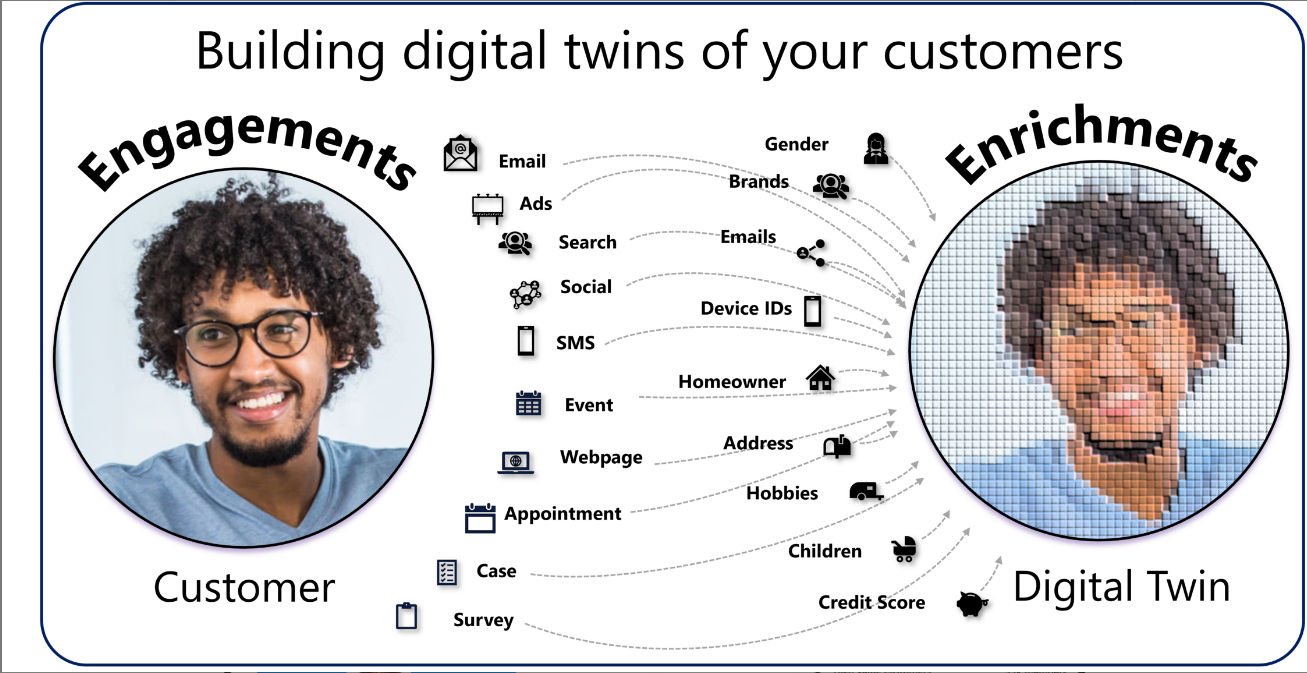Describe unified customer profiles
The first part of any Customer Data Platform (CDP) solution is to provide a consolidated view of customers. By collecting as much data as possible from your organization’s different data sources, you can unify it into a single view of the customer. Many people think of this process as creating a digital twin of your customers. This digital twin understands the digital touch points a customer has with your organization. Every digital activity, such as an email that a customer sends or receives, creates an engagement data point that helps you build a more complete digital twin of your customer.
In addition to understanding the digital activities, to truly gain a 360-degree view of a customer, you need to understand the context of who they are. By considering information like their location, income, or family size, you can better understand who that person is. This level of understanding is often done with the help of enrichment data that can fill in the gaps left by your internal data sources. Enrichment data might include details such as brand affinities, hobbies, financial details, and other demographic information.
The image shows an illustration on the digital twin concept.

As seen in the image, each digital activity captured such as emails, ads they interact with, and social media interactions help to make the "digital twin" picture clearer. This picture is further enhanced by including things such as their hobbies, number of children, and brand loyalties. With a clear and complete "digital twin" that represents who your customers are, you can use that information to gain deeper insights about who they are. These insights help you provide deeper, more personalized experiences.
Customer Insights - Data helps your organization unlock insights, build deeper understandings of your customers, and power personalized customer experiences by unifying your customer data from all your organizations various transactional, behavioral, and observational data sources into a single 360-degree view of the customer. The first part of this process is through data ingestion.
Customer profiles are created by unifying data ingested from your organization's different data sources. Data can be ingested from a wide range of data sources through built-in connectors that connect to many different data providers.
Data can be ingested into Customer Insights - Data in the following ways:
Microsoft Power Query: Used when you want to import data such as Microsoft Dataverse, Azure Blobs, OData sources, etc. For more information, see Power Query Connectors.
Azure Synapse Analytics (preview): Used when you want to connect to Azure Synapse Analytics. For more information, see Connect an Azure Synapse data source.
Azure data lake storage - Used when you want to connect to an Azure Data Lake Storage Gen 2 Account. For more information, see Common Data Folder.
Microsoft Dataverse - Used when you want to connect to data sets in the Dataverse data lake. For more information, see Dataverse.
Once you identify the customer data that you want to use in your unified customer profile, you need to unify the data. The Customer Insights data unification process includes the following steps:
Source columns - Defines which tables and columns are combined to create a unified customer profile.
Duplicate records - Defines how to handle any duplicate records in your datasets.
Matching conditions - Defines the rules that are used to help combine your datasets into a unified customer profile.
Unify customer columns - Defines final information such as which items to exclude, column ranking, and other details that could impact the merge.
By using Customer Insights - Data, you can easily consolidate all your customer data into a single unified customer profile that you can use across your entire organization in the applications that you use every day.